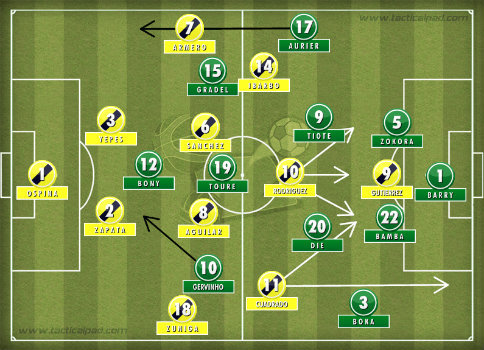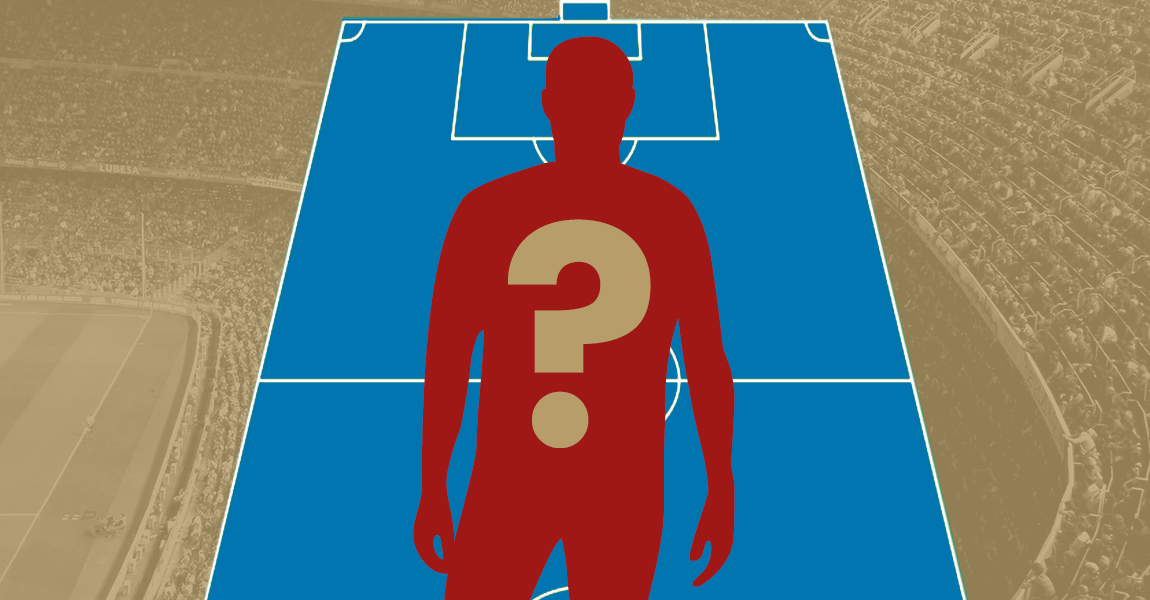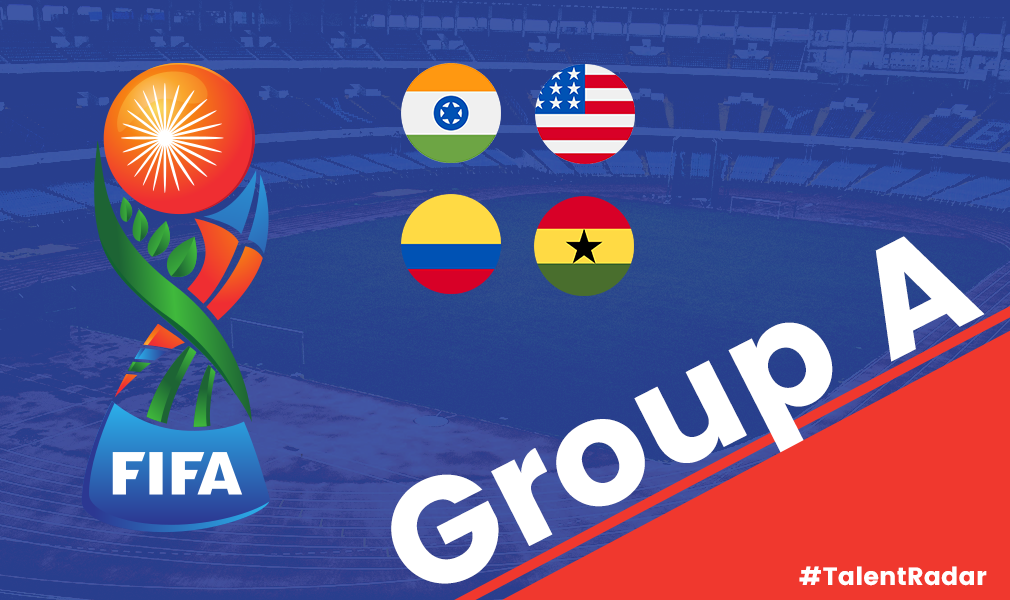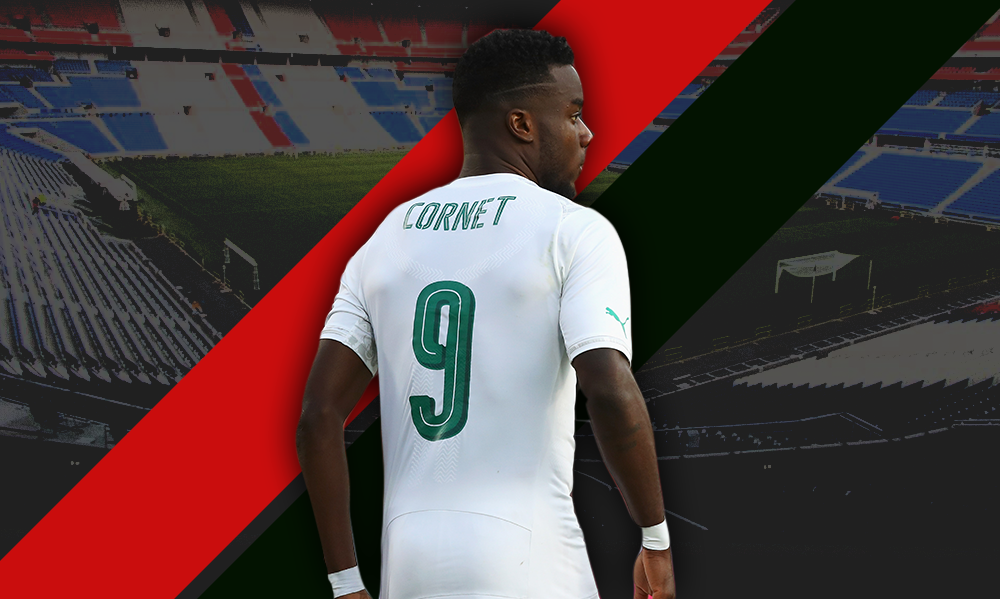With the second round of matches underway, groups are beginning to take shape as teams fight for qualification to the knockout stages. In Brasilia, the two teams from Group C that won their opening encounters, Colombia and Ivory Coast, met to see which team would take sole control of the group. Both teams enjoyed contrasting wins in their opening games: Colombia routed Greece 3-0 while Ivory Coast had to come from behind to beat Japan 2-1. With top spot potentially at stake, both teams were determined not to concede early ground, resulting in a deadlocked first half. However, a flurry of goals in a matter of minutes set up an exciting finish.
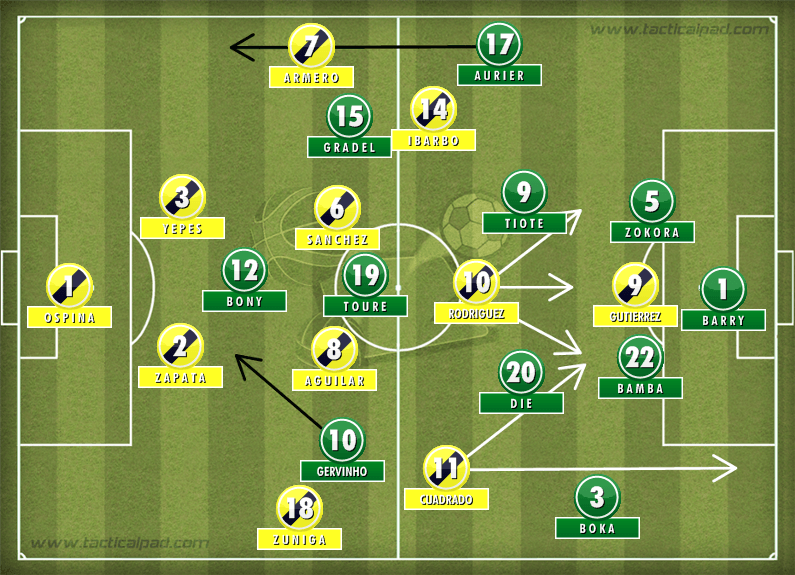
Formation & Line Ups
Colombia (4-2-3-1): Ospina, Zuniga, Zapata, Yepes, Armero (Arias 72’), Sanchez, Aguilar (Mejia 79’), Cuadrado, Rodriguez, Ibarbo (Quintero 53’), Gutierrez
Ivory Coast (4-2-3-1): Barry, Aurier, Zokora, Bamba, Boka, Serey Die (Bolly 73’), Tiote, Gradel (Kalou 67’), Toure, Gervinho, Bony (Drogba 60’)
ANALYSIS
Colombia press high
The attacking quartet of Colombia is known for their dynamic movement and offensive goal threat. However, the front four aided Colombia defensively by employing a high press, stifling Ivory Coast. Colombia pressured the backline of Ivory Coast and quickly closed down players in possession. The approach led to a few turnovers in dangerous positions, such as for the second Colombian goal, but more importantly the high press prevented Ivory Coast from building up an attack from the back. Neither Zokora nor Bamba are the most adept ball-playing center backs, and the Ivory Coast backline struggled to move the ball into midfield. The presence of Tiote and Serey Die, both destroyers rather than playmakers, did not help the Elephants; as a result, much of Ivory Coast’s play started with hopeful long balls out from the back, rather than precise and purposeful build up play.
Counterattacks- Colombia’s transition play, Ivory Coast exploiting space on the wings
With both teams lining up similarly in a 4-2-3-1, the attacking threat of both teams was negated and neutralized to a certain extent, especially in the first half. The method for success in such a situation would be to transition quickly and efficiently from defense to attack. As a result, the majority of chances followed dangerous counterattacks. Los Cafeteros have shown their mastery at counterattacking, with quick passes and wonderful movement. Their combination play overwhelmed Greece in the first game, and once again the South Americans were dangerous on the break. The likes of Rodriguez and Cuadrado have the ability to turn defense into attack in a matter of passes, spreading play with ease. Colombia’s counterattacks never lacked numbers, with many willing runners joining in from midfield and fullback positions.
RELATED ARTICLES
However, as Colombia committed players forward in attack, Ivory Coast had the opportunity to exploit the space left behind. A large part of Colombia’s attacking play is the marauding runs of their fullbacks Armero and Zuniga. Consequently, the Elephants enjoyed a lot of space on the wing to exploit; wingers Gervinho and Gradel threatened on the break and right back Aurier bombed forward at every opportunity. Ivory Coast needed to attack through the wings: holding midfielders Sanchez and Aguilar provided cover for Colombia’s attacking fullbacks; the duo clogged up the midfield. However, Ivory Coast struggled to create meaningful chances, mainly as a result of poor final balls: the Elephants only completed 3 of their 30 crosses in the game. With Ivory Coast struggling to build from the back and through the middle, they needed to exploit the space on the wings; however, the poverty of the final delivery hurt the African side.
Bony isolated, Gutierrez involved
Both teams lined up with a lone striker up front in Teofilo Gutierrez for the Colombians and Wilfried Bony for the Ivorians. However, the two enjoyed contrasting games. Gutierrez was an integral part of Colombia’s transition play as he dropped deeper and made excellent runs into space to move the ball quickly. The River Plate striker had a poor game in front of goal, but he linked up brilliantly with his teammates. His movement opened up space for runners, and Gutierrez contributed to the combination play as well with clever layoffs or intricate one-twos. Colombia might ultimately benefit from Falcao’s injury; while the Monaco forward is a predator in the box, he hinders Colombia to a certain extent as he cannot link up play effectively, whereas Gutierrez excels in such an approach.
On the other hand, Wilfried Bony endured a torrid afternoon under the Brasilia sun. With Ivory Coast struggling to go through the middle, Bony was starved of the ball.While Ivory Coast’s build up play does not usually involve the striker, Bony, who has shown the capability to hold the ball and link up with teammates with Swansea, was isolated and underused. With the Elephants struggling to put in accurate crosses, Bony was a spectator for the majority of the game.
Ivory Coast dominates last 20
Colombia’s quick double shocked the Elephants into action as they hit back through a wonderful piece of individual skill by Gervinho. The goal set up a frantic final 20 minutes as the Elephants attacked the Colombian goal, putting the South Americans under immense pressure. A number of factors contributed to the Elephants’ dominance: Yaya Toure moved deeper into midfield after Serey Die was replaced by winger Bolly and the Manchester City man improved the quality of the Ivorians’ build up play. Gervinho profited on the left wing, looking to link up with his teammates and cut into goal, while Aurier on the other side constantly got into crossing positions. Whereas Bony was often the lone man in the box in the first half as Toure was forced to drop deeper, the Elephants had Drogba, Kalou, Gervinho, Bolly, and Toure in and around the box in the last 20 minutes.
Colombia seemed to wilt under the pressure as well; their usually crisp, precise passing play began to go astray as mistakes creeped into Los Cafeteros’ game. The Colombians conceded possession too easily when breaking forward and sat deep when they defended, inviting pressure. Worryingly for the Colombians, Ivory Coast, like Greece, had more possession, dominating the ball for periods of the game. Against a better team, Colombia could be exposed.
KEY PLAYER OF THE MATCH
While James Rodriguez again controlled the game and young playmaker Juan Quintero dazzled after coming off the bench, winger Juan Cuadrado was crucial for the Colombians in Brasilia. The Fiorentina man dominated the right flank for Colombia; he was an integral part to Los Cafeteros’ brilliant combination play and efficient transition play. Cuadrado tormented left back Boka constantly with his trickery, dribbling, and pace; he was a perpetual danger. With Ibarbo having a poor game on the other wing, Cuadrado’s importance to Colombia’s approach increased. Colombia’s transition play proved the difference in the battle of Group C’s favorites, and Cuadrado was an important component in the counterattacking success. Cuadrado gained his third assist in the World Cup with the corner for Rodriguez’s opener; the partnership between the pacey, creative Colombians will be crucial for the South Americans going forward.
WHERE DOES THIS LEAVE THEM?
This win combined with the draw between Japan and Greece, Colombia qualified for the knockout stages. While first place isn’t certain going into the final group game against Japan, their +4 goal difference gives them the advantage; they would need to lose and Ivory Coast need to win and overcome the goal difference for the Colombians to drop to second. Ivory Coast still sit in second and will still be confident of qualifying for the knockout stages. The Elephants play Greece, a team yet to score despite playing two games, in their final group game and will go in as favorites to win. A draw could also be enough if Japan fails to win against Colombia.
Read all our World Cup 2014 content here
- A Tribute to Robin van Persie - July 23, 2015
- Chris Smalling: Redemption Achieved? - June 10, 2015
- The story of Ashley Young’s resurgence under Louis van Gaal - April 29, 2015




















































